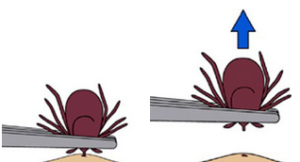Remove
If you find a tick on your body, your children, or your pets it is important to remove it immediately. To properly remove an attached tick, use a plain set of fine-tipped tweezers or a tick removal scoop, and follow the tick removal steps at the University of Maine Cooperative Extension.
 Tick Removal
Tick Removal
1. Use fine-tipped tweezers to grasp the tick as close to the skin’s surface as possible.
2. Pull upward with steady, even pressure. Don’t twist or jerk the tick; this can cause the mouth-parts to break off and remain in the skin. If this happens, remove the mouth-parts with tweezers. If you are unable to remove the mouth easily with clean tweezers, leave it alone and let the skin heal.
4. Dispose of a live tick by submerging it in alcohol, placing it in a sealed bag/container, wrapping it tightly in tape, or flushing it down the toilet. Never crush a tick with your fingers.
5. You can submit a tick specimen to a variety of tick testing labs across New England. For more information on tick testing sites, check out the following websites:
6. Keep the specimen in a sealed container with a blade of grass or submerge in alcohol. See Identify for tick testing resources.
7. If you have had a tick attached to you or your child, remove it, save it, and see a healthcare professional. If the health care provider identifies the bite as high-risk, you will likely be given antibiotics. This follows the new 2019 Guidelines for the Prevention, Diagnosis and Treatment of Lyme Disease.
